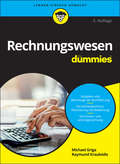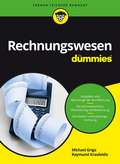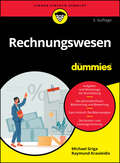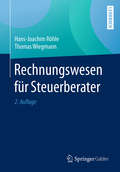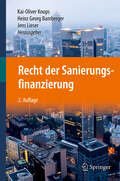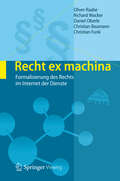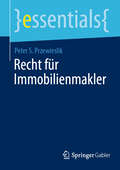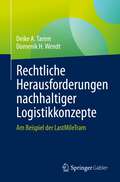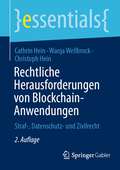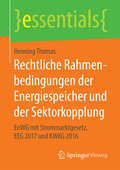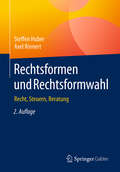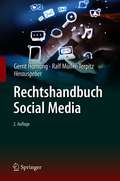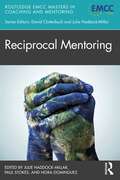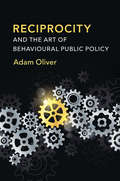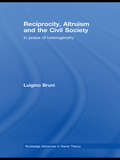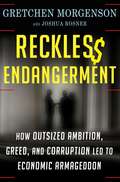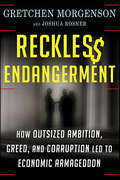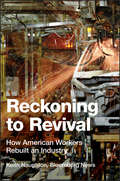- Table View
- List View
Rechnungswesen für Dummies (Für Dummies)
by Michael Griga Raymund KrauleidisDas betriebliche Rechnungswesen hat es in sich - und das gleich in zweierlei Hinsicht: das externe Rechnungswesen mit Buchführung und Bilanzierung und das interne Rechnungswesen mit der Kosten- und Leistungsrechnung. Dieses Buch führt Sie von der Pike auf in diese beiden Rechenwelten ein: Die Autoren erklären die Aufgaben und Spielregeln von Buchführung und Bilanzierung, von den Kontenrahmen über die Buchungs- und Gewinnermittlungsarten bis zur aktiven und passiven Bilanzierung und der Erstellung des Jahresabschlusses und der Bilanzanalyse. Tauchen Sie ein in die Kosten- und Leistungsrechnung und schon bald verlieren Begriffe wie Fixkostendeckungsrechnung und Kostenträgerzeitrechnung ihren Schrecken.
Rechnungswesen für Dummies (Für Dummies)
by Michael Griga Raymund KrauleidisDas betriebliche Rechnungswesen hat es hin sich - und das gleich in zweierlei Hinsicht: das externe Rechnungswesen mit Buchführung und Bilanzierung und das interne Rechnungswesen mit der Kosten- und Leistungsrechnung. Dieses Buch führt Sie von der Pike an in diese beiden Rechenwelten ein: Die Autoren erklären die Aufgaben und Spielregeln von Buchführung und Bilanzierung von den Kontenrahmen über die Buchungs- und Gewinnermittlungsarten bis zur aktiven und passiven Bilanzierung und der Erstellung des Jahresabschlusses und der Bilanzanalyse. Tauchen Sie ein in die Kosten- und Leistungsrechnung und schon bald verlieren Begriffe wie Fixkostendeckungsrechnung und Kostenträgerzeitrechnung ihren Schrecken.
Rechnungswesen für Dummies (Für Dummies)
by Michael Griga Raymund KrauleidisDas betriebliche Rechnungswesen hat es in sich - und das gleich in zweierlei Hinsicht: das externe Rechnungswesen mit Buchführung und Bilanzierung und das interne Rechnungswesen mit der Kosten- und Leistungsrechnung. Dieses Buch führt Sie von der Pike auf in diese beiden Rechenwelten ein: Die Autoren erklären die Aufgaben und Spielregeln von Buchführung und Bilanzierung, von den Kontenrahmen über die Buchungs- und Gewinnermittlungsarten bis zur aktiven und passiven Bilanzierung und der Erstellung des Jahresabschlusses und der Bilanzanalyse. Tauchen Sie ein in die Kosten- und Leistungsrechnung und schon bald verlieren Begriffe wie Fixkostendeckungsrechnung und Kostenträgerzeitrechnung ihren Schrecken.
Rechnungswesen für Steuerberater
by Hans-Joachim Röhle Thomas WiegmannMit diesem Lehrbuch bereiten sich angehende Steuerberater und Steuerfachwirte gezielt auf die Abschlussprüfung im Rechnungswesen (Buchführung und Bilanzierung) vor. Alle prüfungsrelevanten Themen, insbesondere die Bilanzierung und Bewertung von Wirtschaftsgütern (Vermögensgegenständen und Schulden) nach Handels- und Steuerrecht, werden umfassend und verständlich behandelt. Mit zahlreichen anschaulichen Beispielen und Übungsaufgaben ist der Lernerfolg garantiert.
Recht der Sanierungsfinanzierung
by Kai-Oliver Knops Heinz Georg Bamberger Jens LieserZiel des Sanierungsgedankens ist es, Chancen, Risiken und Grenzen der Sanierung und ihrer Finanzierungsdeterminanten auszuloten. Das Praxis-Handbuch zeigt Wege und Möglichkeiten zur Überwindung der Krise auf. Länderberichte aus ausgewählten Rechtsordnungen, in denen der Sanierungsgedanke zum Teil deutlich stärker betont wird, geben zusätzlich Anregungen. Über 30 namhafte Autoren aus Wissenschaft und Praxis stehen für eine ausgewogene Rechtsinterpretation und garantieren eine zuverlässige und aktuelle Aufbereitung der jeweiligen Teilgebiete in komprimierter Form.
Recht ex machina
by Christian Baumann Daniel Oberle Richard Wacker Christian Funk Oliver RaabeIm Internet werden Informationen immer häufiger so ausgezeichnet, dass sie für Computer interpretierbar sind (Semantic Web). Solche maschinenlesbaren Informationen sorgen dafür, dass Dienste im Internet verfügbar gemacht und gefunden werden können. Diese Automatisierung schafft eine neue Rechtslage und stellt sowohl für die Rechtspflege als auch für Geschäftspartner eine Herausforderung dar. In dem Band präsentieren die Autoren eine automatisierte Rechtsfolgenermittlung als praxisrelevanten Ansatz zur Herstellung von Rechtssicherheit.
Recht für Immobilienmakler (essentials)
by Peter S. PrzewieslikDieses essential hilft Maklern dabei, einen ersten Überblick über ihre Rechte und Pflichten sowie über „Fallstricke“ zu geben. Außerdem bietet, Studenten, sich mit den Regelungen des Maklerrechtes vertraut zu machen, Orientierung in kompakter Form. Mieter und Vermieter erhalten einen Überblick über die Rechte und Pflichten von Maklern, vor allem der Zahlungspflicht einer Maklercourtage zu geben.
Recht verständlich formuliert: Klartext statt Amtsdeutsch - Rechtstexte zielgruppengerecht schreiben für Mitarbeiter, Kunden, Bürger
by Martin DunklDieses Buch zeigt, wie komplexe juristische Inhalte in der internen und externen Kommunikation einfach und klar vermittelt werden können. Unternehmen, Behörden und Organisationen stehen häufig vor der Herausforderung, als Nicht-Juristen rechtlich bindende Texte zielgruppengerecht formulieren zu müssen. Hierfür liefert der Autor hilfreiche Werkzeuge und Anregungen. Sie erfahren, wie es gelingt, Bescheide, Anträge, Urteile, Auskünfte etc. für Laien verständlich aufzubereiten und welche psycholinguistischen Werkzeuge genutzt werden können, um Rechtsinhalte erfolgreich zu vermitteln. Mit einfachen Regeln, Mustertexten und praktischen Übungen lernen Sie, komplexe Inhalte in Klartext statt Amtsdeutsch zu verfassen.Ein Buch für Mitarbeitende in Unternehmen, Organisationen, Rechtsabteilungen und Behörden sowie für Studierende, die mit klarer Sprache verständlich und professionell kommunizieren möchten.
Rechtliche Herausforderungen nachhaltiger Logistikkonzepte: Am Beispiel der LastMileTram
by Domenik H. Wendt Deike A. TammDas Buch beleuchtet neue Mobilitätslösungen aus rechtlicher Perspektive. Der Bedarf nach neuen Mobilitätskonzepten im urbanen Raum besteht heute mehr denn je, etwa um die Feinstaubbelastung und den CO2-Ausstoß in Kommunen zu reduzieren und gleichzeitig dem massiven (auch pandemiebedingten) Anstieg des Pakettransports gerecht zu werden. Am Beispiel der LastMileTram wird der Ansatz verfolgt, den Pakettransport auf die Schiene zu verlegen. Hierzu sollen freie Kapazitäten der städtischen Straßenbahnen genutzt und mit der Belieferung durch Lastenräder kombiniert werden. Im Rahmen des Projekts wurden zahlreiche rechtliche Herausforderungen der „Güterstraßenbahn“ identifiziert. Diese werden in diesem Buch vorgestellt. Die rechtliche Analyse umfasst sowohl europarechtliche als auch nationale öffentlich-rechtliche Aspekte. Zudem werden die zivilrechtlichen Haftungsverhältnisse begutachtet. Darüber hinaus werden Anregungen zur Reformierung der Gesetzeslage erörtert.
Rechtliche Herausforderungen von Blockchain-Anwendungen: Straf-, Datenschutz- und Zivilrecht (essentials)
by Cathrin Hein Wanja Wellbrock Christoph HeinDas essential fasst den aktuellen Stand der rechtlichen Herausforderungen der Blockchain-Technologie anhand von Beispielen kurz und prägnant zusammen. Als branchen-revolutionierende Technologie stellt die Blockchain das Recht vor besondere Herausforderungen. Die Pseudonymität der Blockchain-Teilnehmer und die Unveränderbarkeit von in der Blockchain gespeicherten Daten scheinen im Konflikt mit wesentlichen Grundgedanken des Datenschutzrechts zu stehen. Auch die Frage nach der national anzuwendenden Rechtsordnung, der gerichtlichen Zuständigkeit und der Beweiskraft von Blockchain-Transaktionen werfen spannende Fragen auf. Die Autoren erörtern Aspekte des Straf- und Zivilrechts und zeigen Lösungsansätze. Die 2. Auflage des Essentials spiegelt alle rechtlichen Entwicklungen der letzten Jahre wider, sodass die Leser stets auf dem aktuellsten Stand sind.
Rechtliche Rahmenbedingungen der Energiespeicher und der Sektorkopplung: EnWG mit Strommarktgesetz, EEG 2017 und KWKG 2016 (essentials)
by Henning ThomasDieses essential beschreibt die energiewirtschaftsrechtlichen Rahmenbedingungen, unter denen Energiespeicher heute im Zusammenspiel mit anderen Flexibilit#65533;tsoptionen agieren k#65533;nnen. Da Speicher als Letztverbraucher behandelt werden, k#65533;nnen Abgaben, Entgelte und Umlagen beim Strombezug eines Speichers grunds#65533;tzlich anfallen. Von gro#65533;er praktischer Relevanz sind daher mehrere Befreiungstatbest#65533;nde von Abgaben, Entgelten und Umlagen, die in diesem Buch vorgestellt werden. Zudem werden die rechtlichen Rahmenbedingungen f#65533;r die Teilnahme an unterschiedlichen M#65533;rkten dargestellt, die f#65533;r Speicher in Betracht kommen. Das Buch gibt au#65533;erdem einen vertieften Einblick in die regulatorische Entwicklung.
Rechtsformen und Rechtsformwahl: Recht, Steuern, Beratung
by Steffen Huber Axel RinnertNeue Rechtsformen und ständige Reformen im Steuerrecht führen zu einem erhöhten Beratungsbedarf, denn oft ist die gewählte Rechtsform nicht mehr steueroptimal und bedarf der Anpassung an aktuelle Entwicklungen. Das Werk stellt die Rechtsformen in einem direkten Vergleich gegenüber und nennt Vor- und Nachteile in Recht und Steuern. Alle wichtigen Informationen zur optimalen Rechtsform in einem Werk.
Rechtshandbuch Social Media
by Gerrit Hornung Ralf Müller-TerpitzSeit der Entwicklung des Internets zum Web 2.0 sind Social Media aus unserem privaten und beruflichen Alltag nicht mehr wegzudenken. Dienste wie Facebook, Instagram, YouTube, Twitter, WhatsApp, berufliche Netzwerke oder Plattformen für Bewertungen und Blogs haben erhebliche praktische Bedeutung erlangt und werfen zahlreiche, oft ungeklärte oder im Fluss befindliche Rechtsfragen auf. Seit dem Erscheinen der 1. Auflage dieses Handbuchs im Jahre 2015 hat sich zudem der Gesetzgeber dem Phänomen Social Media verstärkt angenommen. Die nunmehr aktualisierte und erweiterte 2. Auflage geht mit wissenschaftlichem Anspruch bei gleichzeitiger Praxisorientierung systematisch auf Rechtsfragen ein, die mit der Nutzung sozialer Netzwerke zusammenhängen. In Gestalt der klassischen Rechtsgebiete des Schuldrechts, Strafrechts, Arbeitsrechts und des Persönlichkeitsschutzes, der neueren Rechtsbereiche des Datenschutzes und E-Governments bis hin zum spezifischen Medien- und Internetrecht sowie unter Einschluss der Kommunikationswissenschaften wird das Phänomen Social Media ganzheitlich erfasst. Abgerundet werden diese Betrachtungen nunmehr durch Beiträge zu den ökonomischen Grundlagen sowie zum wettbewerbsrechtlichen Rahmen der sozialen Medien.
Rechtssicher in der Kinder- und Jugendarbeit: Aufsichtspflicht, Haftung, Datenschutz und alles rechtlich Relevante
by Christian JasperDieses Sachbuch erklärt anschaulich und ausführlich rechtliche Probleme, die sich bei der Vorbereitung und Durchführung von Klassenfahrten, Ferienlagern, Gruppenstunden oder sportlichen Trainingseinheiten für Kinder und Jugendliche ergeben. Der Autor greift Situationen aus der Praxis auf und zitiert gesetzliche Paragraphen nur ergänzend. Zahlreiche Beispiele sorgen dafür, dass das Buch für Nicht-Juristen gut verständlich ist. Formulierungsvorschläge für Einverständniserklärungen oder Anmeldeformulare im Anhang helfen bei der praktischen Arbeit. Ein umfangreiches Stichwortverzeichnis macht das Buch auch für eilige Leser zum unverzichtbaren Begleiter.
Recipe for America
by Jill Richardson"Jill Richardson is a fresh voice in the movement to create a healthier and sustainable food system. This book will be part of the burgeoning food social movement, as it provides a guide to the most important issues and how to work on them."--Marion Nestle"Jill's work at Daily Kos represents the best of the people-powered movement. It's a pleasure to see her work reach a new plateau and come to the attention of a wider audience."--Markos MoulitsasAmerica's food system is dominated by agribusiness and corporate farms, whose destructive practices pollute the environment, are cruel to animals, and offer us unhealthy food choices. Despite this dire situation, most people have little idea how to eat differently, or healthier.In Recipe for America, food activist Jill Richardson shows how sustainable agriculture--where local farms raise food that is healthy for consumers and animals and does not damage the environment--offers the only solution to America's food crisis. In addition to highlighting the harmful conditions at factory farms, this timely and necessary book details the rising grassroots food movement, which is creating an agricultural system that allows people to eat sustainably, locally, and seasonally.A call to action for those who are concerned about what they eat and the health of the planet, Recipe for America shows how sustainable eating nourishes our bodies, our economy, and our environment, and how it is the best hope for the future of food in America.Jill Richardson blogs about food issues at Daily Kos and at her own blog, La Vida Locavore (http://www.lavidalocavore.org). She is also a member of the advisory board of the Organic Consumers Association.
Recipe for Success: An Insider's Guide to Bringing Your Natural Food to Market
by Abigail SteinbergToday's global knowledge economy requires individuals and companies alike to quickly adapt to new tools and strategies. To remain competitive, both must continually upgrade their skills. In the United States, however, support for ongoing education lags far behind other developed nations, creating a crippling skills gap.How did we get to this point, and why are other countries faring markedly better? What keeps our nation's vast network of corporate training, workforce development, and K-12 and college education so fragmented and inefficient? Gathering insights from key thought leaders and exemplary programs, Learning for Life examines:Why America's existing educational models are failing employees and employersThe shift from content knowledge toward new ways of thinking and working, grounded in creativity, critical thinking, communication, and collaborationPolicies and programs that are working in the U.S. and abroadRecommendations for overhauling our education and training infrastructure and building partnerships between providers and employersIn a constantly changing world, the stakes are high to ensure our workforce performs. Learning for Life points to the most promising pathways for getting there.
Reciprocal Mentoring (Routledge EMCC Global Masters in Coaching and Mentoring)
by Julie Haddock-MillarReciprocal mentoring represents an approach to mentoring in organisations that is both timely and of critical importance in the context of diversity, inclusion, equity, and the power shift in mentoring practice. This book provides insight into how reciprocal mentoring programmes can strengthen mutual learning and encourage true partnership between participants. This approach to mentoring places participants on a level playing field; people with disparate expertise, backgrounds, and experience levels are placed in relationships in which they act as both mentor and mentee, generating a range of benefits for all involved. This book explores the design, development, and evaluation of reciprocal mentoring programmes in six different contexts: entrepreneurial, healthcare sector, third sector, education sector, membership organisations, and private sector organisations. Three different approaches to reciprocal mentoring programmes are set out: reciprocal by design, reciprocal by default, and reciprocal as an output. Each chapter describes a number of different case studies which adopt a variety of approaches to reciprocal mentoring programmes, their contextual relevance, and overall impact and contribution. This book will be useful for any individuals and teams involved in the development of mentoring programmes. The range of approaches and frameworks presented in this book will benefit mentoring and coaching practitioners, managers, consultants, professionals in a variety of organisational contexts, and researchers.
Reciprocity and the Art of Behavioural Public Policy
by Adam OliverWhat motivates human behaviour? Drawing on literatures from anthropology to zoology, Oliver examines how we are motivated to give and take, rather than give or take. This book reviews the evolution of reciprocity as a motivator of behaviour, in terms of its observation in non-human species, in very young humans, and in societies that we can reasonably expect are similar to those in which our distant ancestors lived. The behavioural economic and social psychology literature that aims to discern when and in what circumstances reciprocity is likely to be observed and sustained is also reviewed, followed by a discussion on whether reciprocity is relevant to both the economic and the social domains. The dark sides of reciprocity are considered, before turning again to the light, and how the potentially beneficial effects of reciprocity might best be realised. This culminates in the presentation of a new political economy of behavioural public policy, with reciprocity playing a prominent role.
Reciprocity, Altruism and the Civil Society: In praise of heterogeneity
by Luigino BruniThe main emphasis of this new book from Luigino Bruni is a praise of heterogeneity, arguing that society works when different people are able to cooperate in many different ways. The author engages in a novel approach to reciprocity looking at its different forms in society, from cautious or contractual interactions, to the reciprocity of friendshi
Reckitt Benckiser: Fast and Focused Innovation
by Rebecca Henderson Ryan JohnsonSince its 1999 merger Reckitt Benckiser (RB), a global consumer goods company, led by its CEO Bart Becht, RB developed a reputation for rapid product innovation and industry leading profit margins. RB's stated strategy was to focus on its Powerbrands and high growth categories and to nurture the Powerbrands with innovation and roll them out globally. The Powerbrands had steady double digit growth year over year, attracted a devoted customer base and typically grabbed high margins. This case examines the Powerbrands strategy, RB's devotion to fast and focused innovation and its execution of that strategy.
Reckitt Benckiser: Fast and Focused Innovation
by Ryan Johnson Rebecca M. HendersonSince its 1999 merger Reckitt Benckiser (RB), a global consumer goods company, led by its CEO Bart Becht, RB developed a reputation for rapid product innovation and industry leading profit margins. RB's stated strategy was to focus on its Powerbrands and high growth categories and to nurture the Powerbrands with innovation and roll them out globally. The Powerbrands had steady double digit growth year over year, attracted a devoted customer base and typically grabbed high margins. This case examines the Powerbrands strategy, RB's devotion to fast and focused innovation and its execution of that strategy.
Reckless Disregard: Corporate Greed, Government Indifference and The Kentucky School Bus Crash
by James S. KunenA books that covers the historic 1988 Kentucky school bus crash as James follows up with the murder trial of the bus driver and the two lieutenants who were suing the motor company, Ford Motors, to get an improved and safe school bus chasis.
Reckless Endangerment: How Outsized Ambition, Greed, and Corruption Led to Economic Armageddon
by Gretchen Morgenson Joshua RosnerMorgenson, the New York Times's Pulitzer Prize-winning columnist, and Rosner reveal how the financial meltdown emerged from the toxic interplay of Washington, Wall Street, and corrupt mortgage lenders.
Reckless Endangerment: How Outsized Ambition, Greed, and Corruption Led to Economic Armageddon
by Gretchen Morgenson Joshua RosnerA Washington Post Notable Nonfiction Book for 2011One of The Economist's 2011 Books of the Year TheNew York Times's Pulitzer Prize-winning columnist reveals how the financial meltdown emerged from the toxic interplay of Washington, Wall Street, and corrupt mortgage lendersIn Reckless Endangerment, Gretchen Morgenson, the star business columnist of The New York Times, exposes how the watchdogs who were supposed to protect the country from financial harm were actually complicit in the actions that finally blew up the American economy. Drawing on previously untapped sources and building on original research from coauthor Joshua Rosner—who himself raised early warnings with the public and investors, and kept detailed records—Morgenson connects the dots that led to this fiasco. Morgenson and Rosner draw back the curtain on Fannie Mae, the mortgage-finance giant that grew, with the support of the Clinton administration, through the 1990s, becoming a major opponent of government oversight even as it was benefiting from public subsidies. They expose the role played not only by Fannie Mae executives but also by enablers at Countrywide Financial, Goldman Sachs, the Federal Reserve, HUD, Congress, the FDIC, and the biggest players on Wall Street, to show how greed, aggression, and fear led countless officials to ignore warning signs of an imminent disaster. Character-rich and definitive in its analysis, this is the one account of the financial crisis you must read.
Reckoning to Revival: How American Workers Rebuilt an Industry
by Keith NaughtonA special report on the resurgence of the Detroit auto industry using the Chrysler Jeep plant at Jefferson North as a focal point. The report centers on the characters behind the plant and the new technology it is using for manufacturing cars, while also looking at the economic desperation of the neighborhood in which the Jeep plant sits.
